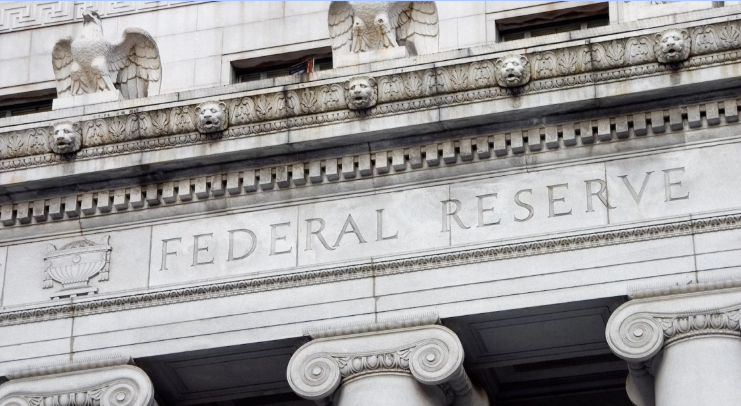In the event of dysfunction in dollar funding markets, the Federal Reserve can supply liquidity through standing central bank swaps. This column considers a scenario in which the Fed declines to extend such credit. It argues that 14 major central banks hold roughly $1.9 trillion in US safe assets. They could form a dollar coalition of the willing by pooling their dollar holdings and swapping them when needed. An inferior international lender of last resort beats no international lender of last resort.
On 16 April 2025, Federal Reserve Chair Jay Powell (2025) assured Professor Raghu Rajan that the Fed stands ready to supply dollar liquidity through standing central bank swaps. 1 When needed, the Fed can lead international last resort lending of dollars by extending hundreds of billions of its credit to partner central banks that in turn lend to their banks against collateral. Powell stressed that in doing so, the Fed ensures the transmission of its own policy when global dollar funding markets dry up. He cited the example of a foreign bank funding a security backed by US household debts (Reis and Bahaj 2018).
In 2008 and 2020, the amounts that the Fed swapped were not small, but offshore dollar funding – both on- and off-balance-sheet – is measured in the tens of trillions of dollars. Thus, with pennies on the dollar lent and repaid with interest, the Fed and co-operating central banks calmed dollar panics.
In the light of events in early 2025, this column considers the unlikely possibility that the Fed does not take the lead in international dollar lending of last resort in the event of dysfunction in dollar funding markets. What if some future Fed leadership were to decline to extend its credit through central bank swaps, taking the view that they “just hate bailing out Europe again,” in the unguarded phrase of the US Vice President (Goldberg 2025)? Or to condition swaps on bilateral political considerations?
This scenario is worth exploring even if one deems it very unlikely. A new Fed Board leadership would have to persuade the Federal Open Market Committee (FOMC) to reverse the policy just affirmed by Chair Powell. By law, the FOMC controls Fed open market operations, including the central bank swaps. 2
A glance at the recent additions to the current FOMC lineup suggests that it would not readily agree to withhold standing central bank swaps for political reasons. On 21 April, the New York Fed appointed European Central Bank (ECB) operations veteran Anna Nordstrom to head its markets group, managing the FOMC’s $6.3 trillion System Open Market Account. Her crisis-tested predecessor, Lorie Logan, has headed the Dallas Fed since 2022. 3 Last year, another New York Fed veteran, Alberto Musalem, and a former Goldman Sachs global treasurer, Beth Hammack, became the heads of the St Louis and Cleveland Feds, respectively. By the wisdom of the Congressional framers of the Federal Reserve Act, none is a presidential appointee. 4
That said, after trans-Atlantic differences surfaced over NATO, Ukraine, and trade in March 2025, 5 but even before the so-called reciprocal tariff announcement in early April, the reliability of the Fed as a source of dollar swaps came into question (Smart 2025). On 20 March, a think tank report to the European Parliament considered a scenario of “politicise[d]…recourse to the dollar swap lines” (Tudoir et al. 2025). More telling was a Reuters story on the same day, widely sourced by a large team of writers, that reported that European central bankers were discussing how to make do without the Fed swaps. 6 Citing the Reuters story, Deutsche Bank’s foreign exchange strategist George Saravelos (2025) called this a ‘nuclear button’. 7
This scenario takes us to the Kindleberger Trap, the risk that a fading world power lacks the ability, but the ascendant power lacks the will, to provide the world with vital public goods — such as stable international money. In 1931, the Bank of England (BoE) was not able, but the Fed was not willing, to serve as lender of last resort to Austria. As a result, the crisis rolled on to Germany, Britain, and ultimately the US. The Kindleberger Trap caught the “world in depression”, as Charles Kindleberger (1973) titled his seminal work. 8 Nowadays, it is not, as Joseph Nye (2017) imagined, that the Fed is unable to play lender of last resort and the People’s Bank of China is unwilling.
Instead, the hazard to the world economy now is that:
1. The Fed is able to lead a dollar lender of last resort operation, but
2. A future Fed may not be willing to do so, and
3. No one else is able to do so.
This column proposes a work-around:
4. A coalition of central banks can pool dollars to lend as a last resort.
Central banks without access to the Fed could form a dollar coalition of the willing. 9 The 14 central banks that had standing and temporary Fed swap lines in 2008 and 2020 span dollar funding markets to a remarkable extent, which is not generally recognised (Ito et al. 2021). Among them they cover about three-fourths of offshore dollar liabilities of non-US headquartered banks and about five-sixths of global turnover against the dollar in the foreign exchange swap market (Figures 1 and 2 from McCauley 2024).
Figure 1 Dollar liabilities of banks headquartered outside the US


Note: 1 Cross-border and local liabilities in all instruments vis-à-vis all counterparty countries. Excludes intragroup positions but includes liabilities to other (unaffiliated) banks. From end-2015, includes positions reported by China and Russia (the latter up to end-2021).
Sources: BIS consolidated banking statistics; BIS locational banking statistics; author’s calculations.
Figure 2 Coverage of dollar foreign exchange swap turnover by Fed central bank swaps in 2007-2022


Note: Big 5: European Central Bank, Bank of Japan, Bank of England, Bank of Canada, and Swiss National Bank, advanced economy (AE) 5: Reserve Bank of Australia, Riksbank, Norges Bank, Danmarks Nationalbank, Reserve Bank of New Zealand; emerging market (EM) 4: Monetary Authority of Singapore, Banco de Mexico, Bank of Korea, and Central Bank of Brazil.
Source: BIS Triennial Central Bank Survey of foreign exchange of 2007, 2010, 2013, 2016, 2019, 2022, author’s estimates for Danish krone, author’s calculations.
A key fact is their collective firepower: the 14 central banks hold lots of dollars. Their collective holdings of US safe assets amounted to an estimated $1.9 trillion at the end of 2021. 10 The 14 central banks cannot, like the Fed, create dollars without limit, but they could pool their holdings and swap them when needed.
There is ample precedent for central banks to lend each other international money that is not of their own creation. In the 19th century, precious metal loans did not lack a geopolitical dimension but could not be unlimited.
A legendary story tells how the Silver Train (Silberzug) chugged from Vienna to Hamburg in 1857. Agreeing to a call for help on 8 December, the Bank of Austria loaded a train with almost ten million ounces of silver. 11 It arrived on 12 December “in highly visible fashion” (Deutsche Boerse 2025, Roberds and Velde 2014, p 45) in time to prevent the impending failure of most of Hamburg’s banks and to allow ship captains to unload their cargoes with some hope of getting paid (Aliber et al. 2023, pp 294-295). The Bank of Prussia evidently regretted having joined London and Paris in turning Hamburg down before Vienna said yes and having thus ’missed an opportunity’. 12
During the 1890 Baring Crisis, it took the Banque de France about a day to send 707,547 ounces of gold, worth £3 million, from Paris to London by wagon, train, and ship. 13 The crates of gold ‘supposedly’ recrossed the Channel unopened (Flandreau 1997), 14 but in any case, signalled that sterling was as good as gold. The BoE Governor “and the City were uneasy about asking the French and the Russians for help…Suppose for some political-financial reason they had been unwilling to oblige?” 15 These metallic last resort loans calmed panics even though neither drew on alchemy to extend unlimited support.
In the modern era, central bank mutual support has mixed money creation and dollar reserve use in varying proportions. In the record-breaking $3 billion support for the Bank of England in November 1964, the US, German, French, and Swiss central banks pledged 59% in their own currencies and the other G-10 members and the Bank for International Settlements (BIS) pledged 41% in dollars (Schenk 2010, p 276). The June 1976 record-breaking $5.3 billion credit to the Bank of England reversed the proportions, as apparently only the Fed pledged its own currency for 38% and the other G10 members and the BIS stumped up dollars for their 62% share. 16
Thus, in an historical perspective, the 2008 pattern of the Fed, the ECB, and the Swiss National Bank (SNB), each swapping its own currency, stands out as an exception. Much of last resort lending by central banks to each other has involved lending own reserves rather than freshly created money.
With this perspective, the $1.9 trillion possible pool is big money. It’s triple the previous maximum drawing on the Fed swap lines in 2008 ($598 billion) and quadruple the peak 2020 usage ($449 billion) (Choi et al. 2022). The coalition would signal an independent judgement of the nature of the crisis, backed by money, like a Fed swap, as opposed to each central bank in need drawing only on its own resources. And if the Fed could trust the 14 central banks, how could they not trust each other?
Where the pool could fall short would be in signalling that there is plenty more where this came from. If the $1.9 trillion were deemed too small, coalition members could ex ante raise the dollar share of their reserves, reversing diversification into Canadian and Australian dollars, renminbi, and other currencies (Arslanalp et al. 2022). Or highly rated countries could borrow dollars ex ante to add to reserves at low cost. 17
Leadership could arise among the Fed’s standing swap partners – the ECB, Bank of Japan (BoJ), SNB, BoE, and Bank of Canada. The ECB and BoJ were the largest users of the Fed swap lines in 2008 and 2020, respectively. During the 2023 run on Credit Suisse, the SNB acquired unique experience in tapping the New York Fed for $60 billion against US Treasury collateral under the FIMA (foreign and international monetary authorities) repo facility (Martin 2024).
The coalition could enlist the BIS for technical support as an agent as European central banks did in 1973-95 (ECB 2025). Or the BIS could serve as intermediary, as it did when the New York Fed lent dollars through the BIS to offshore banks in the 1960s to prevent funding crunches (McCauley and Schenk 2020).
Using reserves rather than money creation to fund swaps has a snag: the $1.9 trillion is invested, and a crisis calls for electronic cash. If the Fed were to deny swaps, would it continue to provide same-day FIMA funding against Treasuries held in custody?
If it did, the coalition could arrange to access hundreds of billions of dollars in same-day funds to meet a panic. If the Fed did not, then it would end up providing ad hoc funding. Here is why.
Without the FIMA backstop, heavy central bank sales of US Treasuries would rock the US bond market. Such selling could prod the Fed into the market as buyer of last resort — as in March 2020, before the FIMA repo was introduced.
Without the FIMA backstop, central banks might seek to repo hundreds of billions in Treasuries for cash in the market. Such funding could well prod the Fed to cap market repo rates. After all, the recent benchmark rate shift from dollar LIBOR to repo-based SOFR means that the Fed’s own domestic monetary transmission requires well-behaved repo rates.
One way or another, the coalition would need to work with the Fed to manage any ‘dash for cash’ (Barone et al. 2022).
Limits excite. It may well be, as Eurosystem sources grimly noted to Reuters, that “there is no good substitute to the Fed” (Martinuzzi et al. 2025). Even a large pool of dollar reserves would not stack up to ‘whatever it takes’ Fed swaps, as demonstrated neatly in Korea during the 2008 Global Crisis (Baba and Shim 2014).
Nonetheless, a dollar coalition of the willing could pool trillions of dollars to backstop global dollar funding with no more than self-interested Fed help. An inferior lender of last resort beats no lender of last resort.
Source: cepr.org



